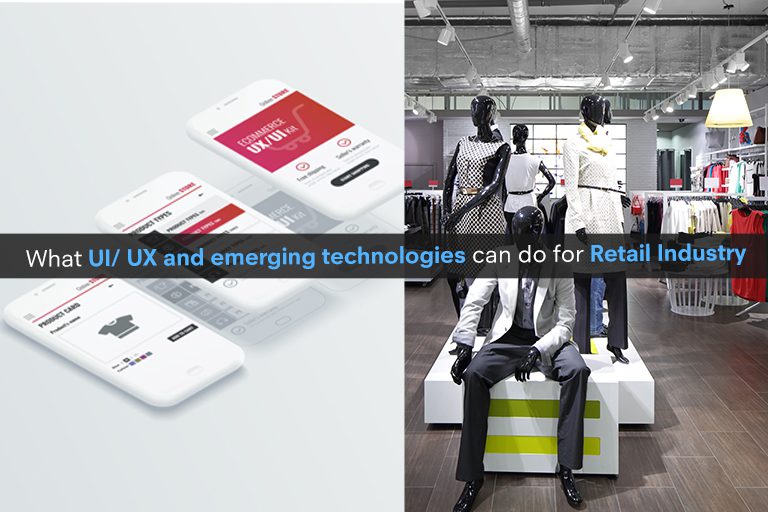There is no doubt that the retail sector has changed leaps and bounds over the past decade. With technology aiding the sector in ways unimaginable a few decades ago, digital retail is a game changer in ways it offers various experiences to its users. These experiences are essentially User Experience Design ( UX Design) – a process wherein the main objective is to focus on all aspects of a product offering; its development, design, functionality, usability and branding. UX design works on human computer interaction and making sure the interface design is easy to access while offering a unique experience. Designers in this regard are responsible for identifying new opportunities for businesses where their work focuses on the entire end-to-end journey of a user’s interaction with the brand ( its products, offerings, services, information etc.) In a simple example, when you visit a website and find your purchase experience to be easy, then the UX design is a good one.
In the retail industry we have seen that a brand’s UX design has been able to offer them a set of loyal customers. How?
Well, don’t we all crave for a hassle free and easy check out at the end of our digital shopping. Customers seek a simpler journey to the purchase and comfortable experiences. In this regard, UX design is noted to be vital behind the success of a business. Digital retail sector has now reached a point where it has become almost impossible to differentiate between one brand’s UX design to another. This pushed UX designers from building simpler, easy to navigate interfaces to storytelling – making a unique offering from the brand to its customers.
Also Read: Innovative Product Design Ideas That Impacted The World
With global giants like Google, YouTube and Amazon, these story tellers in UX design are now called UX writers who are experts in writing unique storylines for products, campaigns and brands. Making copywriting a strong component of their UX design, it has helped them to connect with their users at a deeper level. Working with evoking human emotions and embedding nostalgia in stories.
One can easily say that a good UX design will offer a good experience to the customers leading to sales and word of mouth. UX design can hence be make-or-break for any retail brand. Here are a few factor that are considered to be good in UX design:
- Design that is complementing the overall brand and retail experience
- Design that promotes a product/ offering
- Design that offers security of user data
- Design that works with visual elements
- Design that offers simplicity to operate and navigate
- Design that helps easy purchase options
Also Read: Innovative Product Design Ideas That Impacted The World
Retail industry’s automation in UX Design
With the boom of the internet and dynamic nature of tech, E-commerce has taken over the retail industry by a storm and automation in processes is not simply an innovation but a necessity. With the pandemic pushing the world to exist virtually for almost everything and the global population spending majority hours online, customers now are more than ever used to a seamless, easy and user-friendly shopping experience. To avoid public places, the global population shopped online in a hassle free manner, and in this regard – good UX design became imperative for brands in fashion, lifestyle, accessories, service based products and much more.
Brick and Mortar:
In the words of Steve Jobs ‘Design is not just what it looks like and feels like, design is what it does’ – which brings us to intuitive thinking and design – essential components in building a brand’s experience in the minds of a customer.
-
Digital / Self checkout counters
If a store has a long wait at their-checkouts, customers are bound to gravitate to other stores that offer more intuitive experience in their shopping. This is where UX design helped bridge the gap and introduced automated digital self-checkout counters at retail stores that avoid human contact – which were a great win during pandemic. This helps us to learn how automation can help in further building efficiencies and the future of retail.
-
Digital Mirrors/ Smart Mirrors
Another experience is the digital mirror/ smart displays. When we have a little too many fashion garments to try on at once, this AR tech powered mirror helps customers to see themselves in virtual reality of how the garment will fall on their body type, change your garments, hairstyle, hair color, make up and much more. Brands like Timberland and Topshop are already making use of this technology.
-
Instore AR navigation
Each store is built, styled and designed differently, and at times we find ourselves lost searching for what we need – seeking a human to help us point to the right direction. AR navigation is now the solution to this hassle. It helps in making your in-store experience more interactive and engaging while giving you informative directions that are useful for your shopping experience. You can find what you are looking for without wasting your time.
West’s famous hardware store, Lowe’s is known to use an application named Lowe’s Vison that helps its customers to navigate the store.
Also Read: New-Age Design Philosophies of Global Brands
Online/E-commerce:
AR & VR are an essential component today for UX design. No e-commerce / application can offer unique experiences without building an element that works with AR/ VR to enhance a user’s experience. Augmented Reality and Virtual Reality are both part of emerging tech, expensive technologies at the moment, that are working on building a virtual world – involving how humans will see, feel and emote in the virtual reality. Offerings include:
Also Read: Top 5 Inspirational Designers of All Time
-
Virtual try-ons
We have all been unsure to purchase a product online without really trying it on during our online purchases. AR experience has enchanted this by building a user-friendly virtual try-on for customers. At the comfort of your home you can try a product on to have a sense of how it may look on you before your purchase. Example, Sephora, the global retailer in personal care and beauty, lets you try on its lipsticks, eye-lashes ( faux) and eyeshadows virtually.
-
AR apps for Shopping
Visiting a store too taxing for you, especially with global lockdowns?
Well, brands came to rescue here by building a full scale shopping experience, only online – Virtually, that is. With wide supermarkets to exclusive luxury retail experiences, brands made the most use of AR technology and virtual headsets in hands of its customers at home to offer them an experience of being in a store, adding product to a cart and shopping comfortably from home. Of course, everything you buy will be delivered to your doorstep. -
Gaming Experiences
Brands are now trying to connect virtually with their customers in any way possible, and with metaverse building its way up, gaming is one of the most sought out sectors at the moment. Building AR gaming experiences is now a great power play by a brand that aids in offering its customers a quirky and unique way of engaging and interacting with the brand while having fun and enjoying themselves. These gaming experiences also offer digital product lines for customers virtual closets that can be highlighted and shared via social media and also links to digital storefronts of the brands.A research by Shopify in 2020 reflected how products with 3D/ AR experiences showed a 94% higher conversion rate. While AR is making its own waves, AI – Artificial Intelligence, another automated technology, has been taking over almost every industry. Brands are using AI in the form of chat bots on their e-commerce/ application as well as their in-stores assistants to customers. It is similar to having yourself a google assistant or Siri.
Also Read: UI VS UX Design: What’s The Difference
These give us a fair idea on how broad the scope of UX design is and how it entails everything that can possibly help in improving the user experience with the product or the brand overall. The growth and rise of tech in our everyday lives will also give rise to new experience over the coming years. As a result of these changes, brands are seeking seasoned designers in UX who are also working keeping in mind business implications such as cost of implementation, global reach, competition analysis and more.



Want to Become a Designer ?
Strate is a unique design school that nurtures your talents as a designer by offering state-of-the art designing courses in Bangalore.
Join Strate